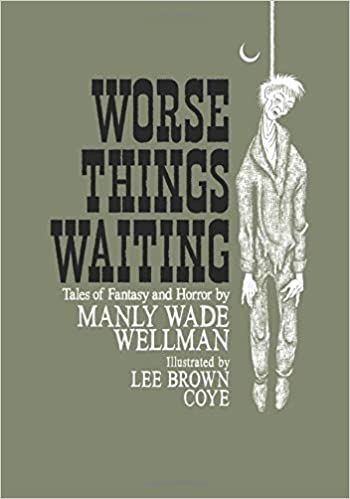 In 1950, towards the end of Weird Tales‘s run, yet just before his first John the Balladeer story, Manly Wade Wellman turned to the forest for inspiration for a ghost story, “The Pineys”. For amid the dense longleaf pines lives a strange folk known as the Pineys, and those who trespass into their lands vanish. The Indians who once lived around this particular pine grove say that the Pineys were there first. Some even say that the Pineys have been defending their groves since before the dinosaurs, and that their king walks among humanity, ever vigilant for those who would disturb his pine groves. What is clear, as many who live uneasily around the pines repeat, is that no one knows what the Pineys do to those who they capture.
In 1950, towards the end of Weird Tales‘s run, yet just before his first John the Balladeer story, Manly Wade Wellman turned to the forest for inspiration for a ghost story, “The Pineys”. For amid the dense longleaf pines lives a strange folk known as the Pineys, and those who trespass into their lands vanish. The Indians who once lived around this particular pine grove say that the Pineys were there first. Some even say that the Pineys have been defending their groves since before the dinosaurs, and that their king walks among humanity, ever vigilant for those who would disturb his pine groves. What is clear, as many who live uneasily around the pines repeat, is that no one knows what the Pineys do to those who they capture.
Nothing but tall tales and campfire scares, right?
Beau Sawtelle believes so, and it is his job to survey the piney grove for logging. He’s brought his niece, some men, and a local named Mac to assist him. The local tales of strange and furred creatures don’t scare Sawtelle’s party, but rather provide a bit of amusement as they journey deep into the forest. But as the canopy darkens overhead and the shadows grow longer, the discussion takes a more fearful turn as they discuss the Pineys’ king while they make a campfire…
Some stories just ache to be told out loud, and this last gasp of a Gothic tale, stitched together from campfire recollections and short tales, sounds like the stories told late at night by a storyteller aiming for a little mischief. As mentioned, this is a ghost story, so the impact rests on the final revelation, heightened further by whom the narrator is.
All the hallmarks of a proper Wellman tale are present. Mac’s voice is reminiscent of John the Balladeer, who would first appear in “O Ugly Bird” a mere three months later. The Pineys themselves fit the inventive bestiary that fills Wellman’s tales, and he even draws a distinct parallel to the Shonokins, a race that filled several of his earlier Weird Tales. And finally, Sawtelle’s niece relies on the same European folk magic and grimoires that John the Balladeer would use to great effect in his short stories. It’s easy to see “The Pineys” as a sinister rehearsal for what would John’s adventures, even more so than the already acknowledged “Frogfather” or “Sin’s Doorway”.
You might call wandering Mac “John…” Just don’t call him a good man.
“The Pineys” may be a simpler scare than the heyday of Weird Tales under Farnsworth Wright, but atmosphere and voice can make even the simplest tales breathe with sinister life. Fortunately, the most affordable place to find “The Pineys” is in the new reprint of Worse Things Waiting, which is still available through Amazon.
“Worse Things Waiting” is a great collection of Wellman’s work. I read it when it was first published by Carcosa back in the 1970s. When I saw that it was being republished and at a very reasonable price, I bought a copy at once. For anyone who enjoys Wellman’s stories or who wants a good introduction to his work, it is a great buy.
My favorite story in the collection is “Up Under the Roof”. I first read it when I read this book 45 years ago and remembered ever since. It is a very short, very simple and very scary tale.
Shadowridge Press did Wellman/weird fiction fans a big service reprinting this collection. The story choices made by Wagner, Wellman and Drake back in the ’70s are still spot on.
-
A hearty agreement with both your statements.
David Drake was both a friend of Manly Wade Wellman and an admirer of his work. Drake’s stories of “Old Nathan” (collected in the book of that title) were written partly as a tribute to Wellman. Old Nathan, the title character, is a “cunning man” or hedge wizard in the Southern mountain country early in the 19th Century. He calls himself “The Devil’s Master”. Among other powers, he can understand and speak to animals. Of course, these being stories by David Drake, Old Nathan is definitely no Dr. Doolittle. If you like Drake’s work, I recommend it.